About 1/5 of websites you need to scrape use Cloudflare, a hardcore anti-bot protection system that gets you blocked easily. So what can you do? 😥
We spent a million dollars figuring out how to bypass Cloudflare in 2024 so that you don't have to and wrote the most complete guide (you're reading it!). These are some of the techniques you'll get home today:
- Method 1: Get around Cloudflare CDN.
- Method 2: Bypass the waiting room and reverse engineer the challenge.
- Method 3: Use Cloudflare solvers.
- Method 4: Fortified headless browsers.
- Method 5: Smart proxy.
- Method 6: Scrape Google Cache.
- Method 7: Avoid CAPTCHAs.
- Method 8: API to bypass Cloudflare (easiest and most reliable).
Let's be the winners in this scraping story. Scroll down! 😎
What is Cloudflare Bot Management
Cloudflare is a web performance and security company. On the security side, they offer customers a Web Application Firewall (WAF). A WAF can defend applications against several security threats, such as cross-site scripting (XSS), credential stuffing, and DDoS attacks.
One of the core systems included in their WAF is Cloudflare's Bot Manager. As a bot protection solution, its main goal is to mitigate attacks from malicious bots without impacting real users.
Cloudflare acknowledges the importance of certain bots. For example, no site wants to deliberately block Google or other search engines from crawling its webpage. To account for this, Cloudflare maintains an allowlist for known good bots.
Unfortunately for web-scraping enthusiasts like you and me, they also assume all non-whitelisted bot traffic is malicious. So, regardless of your intent, there's a good chance your bot gets denied access to a Cloudflare-protected web page.
If you've tried to scrape a Cloudflare-protected site before, you may have run into a few of the following Bot-manager related errors:
- Error 1020: Access Denied
- Error 1010: The owner of this website has banned your access based on your browser's signature
- Error 1015: You are being rate limited
- Error 1012: Access Denied
Typically, these challenges are accompanied by a Cloudflare 403 Forbidden HTTP response status code.
How does Cloudflare detect bots?
The bot detection methods used by Cloudflare can generally be classified into two categories: passive and active. Passive bot detection techniques consist of fingerprinting checks performed on the backend, while active detection techniques rely on checks performed on the client side. Let's dive into a few examples from each category together!
Cloudflare passive bot detection techniques
Here's a non-exhaustive list of some passive bot detection techniques Cloudflare employs:
Detecting botnets
Cloudflare maintains a catalog of devices, IP addresses, and behavioral patterns known to be associated with malicious bot networks. Any device suspected to belong to one of these networks is either automatically blocked or faced with additional client-side challenges to solve.
IP address reputation
A user's IP address reputation (also known as risk score or fraud score) is based on factors such as geolocation, ISP, and reputation history. For example, IPs belonging to a data center or known VPN provider will have a worse reputation than a residential IP address. A site may also choose to limit access to a site from regions outside of the area they serve since traffic from an actual customer should never come from there.
HTTP request headers
Cloudflare uses HTTP request headers to determine if you're a robot. If you have a non-browser user agent, such as python-requests/2.22.0, your scraper can easily be picked out as a bot. Cloudflare can also block your bot if it sends a request that is missing headers that would otherwise be there in a browser. Or if you have mismatching headers based on your user-agent. For example, including a sec-ch-ua-full-version-list: header for a Firefox user-agent.
TLS fingerprinting
This technique enables Cloudflare's antibot to identify the client being used to send requests to a server.
Though there are multiple methods of fingerprinting TLS (such as JA3, JARM, and CYU), each implementation produces a fingerprint that is static per request client. TLS fingerprinting is helpful because the TLS implementation of a browser tends to differ from that of other release versions, other browsers, and request-based libraries. For example, a Chrome browser on Windows (version 104) would have a different fingerprint than all of the following:
- A Chrome browser on Windows (version 87)
- A Firefox browser
- A Chrome browser on an android device
- The Python HTTP requests library
The construction of a TLS fingerprint happens during the TLS Handshake. Cloudflare analyzes the fields provided in the 'client hello' message, such as cipher suites, extensions, and elliptic curves, to compute a fingerprint hash for a given client.
Next, that hash is looked up in a database of pre-collected fingerprints to determine the client the request came from. Suppose the client's hash matches an allowed fingerprint hash (i.e., a browser's fingerprint). In that case, Cloudflare will then compare the user-agent header from the client's request to the user-agent associated with the stored fingerprint hash.
If they match, the security system assumes that the request originated from a standard browser. On the contrary, a mismatch between a client's TLS fingerprint and its advertised user-agent indicates obvious use of custom botting software, resulting in the request being blocked.
HTTP/2 fingerprinting
The HTTP/2 specification is the second major HTTP protocol version, published on May 14, 2015, as RFC 7540. The protocol is supported by all major browsers.
The main goal of HTTP/2 was to improve the performance of websites and web applications by introducing header field compression and allowing concurrent requests and responses on the same TCP connection. To accomplish this, HTTP/1.1's foundation was expanded with new parameters and values. These new internals are what the HTTP/2 fingerprint is based on.
The binary framing layer is a new addition to HTTP/2 and is the central focus of an HTTP/2 fingerprint.
If you're interested in a more in-depth analysis of HTTP/2 fingerprinting, you should read Akamai's proposed method for fingerprinting HTTP2 clients here: Passive Fingerprinting of HTTP/2 Clients. But for now, here's a summary:
Three main components form an HTTP/2 fingerprint:
-
Frames:
SETTINGS_HEADER_TABLE_SIZE, SETTINGS_ENABLE_PUSH, SETTINGS_MAX_CONCURRENT_STREAMS, SETTINGS_INITIAL_WINDOW_SIZE, SETTINGS_MAX_FRAME_SIZE, SETTINGS_MAX_HEADER_LIST_SIZE, WINDOW_UPDATE - ** Stream Priority Information:**
StreamID:Exclusivity_Bit:Dependant_StreamID:Weight -
Pseudo Header Fields Order: The order of the
:method,:authority,:scheme, and:pathheaders.
If you're curious, you can test a live HTTP/2 fingerprinting demo by clicking here.
Like TLS fingerprinting, each request client will have a static HTTP/2 fingerprint. To determine a request's legitimacy, Cloudflare always verifies that the fingerprint and user-agent pair from the request matches a whitelisted one stored in their database.
HTTP/2 fingerprinting and TLS fingerprinting go hand in hand. Out of all the passive bot detection techniques Cloudflare uses, these two are the most technically challenging to control in a request-based bot. However, they're also the most important. So, you want to ensure you do them right or risk getting blocked!
Alright! By now, you should have a good understanding of how Cloudflare detects bots passively. But, remember: that's only half of the story. Now, let's take a look at how they do it actively!
Cloudflare active bot detection techniques
When you visit a Cloudflare-protected website, many checks are constantly running on the client-side (i.e., in your local browser) to determine if you're a robot. Here's a list of some methods they use (once again, non-exhaustive):
CAPTCHAs
In the past, CAPTCHAs were the go-to method for detecting bots. However, it's well-known that they harm the end user's experience. Whether or not Cloudflare serves the user a captcha is dependent on several factors, such as:
- The site configuration. A website administrator may choose to enable CAPTCHAs all the time, sometimes, or never at all.
- Risk Level. Cloudflare may choose to serve a CAPTCHA only if the traffic is suspicious. For example, a CAPTCHA may be shown if a user browses a site using the Tor client, but not if the user runs a standard web browser like Google Chrome. For these cases, a Cloudflare CAPTCHA bypass is possible and we'll see how below.
Previously, Cloudflare used reCAPTCHA as their primary captcha provider. But, since 2020, they've migrated to use hCaptcha exclusively. Below is an example of hCaptcha appearing on a Cloudflare-protected site:
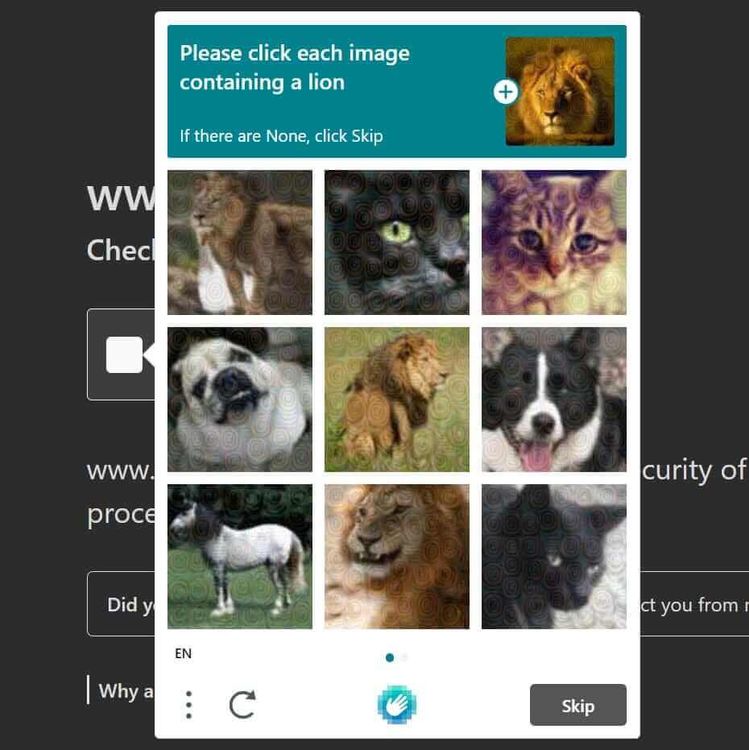
Canvas fingerprinting
Canvas fingerprinting allows a system to identify the device class of a web client. A device class refers to the combination of browser, operating system, and graphics hardware of the system used to access the webpage.
Canvas is an HTML5 API used to draw graphics and animations on a web page using JavaScript. To construct a canvas fingerprint, a webpage queries your browser's canvas API to render an image. That image is then hashed to produce a fingerprint.
This technique relies on taking a system's graphic rendering system as a physically unclonable function. That might sound complicated, so let me explain it.
A canvas fingerprint depends on multiple layers of the computing system, such as:
- Hardware. GPU
- Low-level Software. GPU driver, Operating system (fonts, anti-aliasing/sub-pixel rendering algorithms)
- High-Level Software Web Browser (image processing engine)
Because a variation in any of these categories will produce a unique fingerprint, this technique accurately differentiates between device classes.
I want to clarify this: a canvas fingerprint doesn't contain enough information to sufficiently track and identify unique individuals or bots. Instead, its main purpose is to distinguish between device classes accurately.
In the context of bot detection, this is useful because bots tend to lie about their underlying technology (via their user-agent header). Cloudflare has a large dataset of legitimate canvas fingerprints + user agent pairs. Using machine learning, they can detect device property spoofing (ex. user-agent, operating system, or GPU) by looking for a mismatch between your canvas fingerprint and the expected one.
Cloudflare uses a specific canvas fingerprinting method, Google's Picasso Fingerprinting.
If you'd like to see canvas fingerprinting in action, check out Browserleak's live demo.
Event tracking
Cloudflare adds event listeners to webpages. These listen for user actions, such as mouse movements, mouse clicks, or key presses. Most of the time, a real user will need to use their mouse or keyboard to browse. If Cloudflare sees a consistent lack of mouse or keyboard usage, they can assume the user is a bot.
Environment API querying
This is a very broad category. A browser has hundreds of Web APIs that can be used for bot detection. I'll do my best to split them up into 4 categories:
-
Browser-specific APIs. These specifications exist in one browser but may not exist in another. For example,
window.chromeis a property that only exists in a Chrome browser. If the data you send Cloudflare indicates that you're using a Chrome browser but send it with a Firefox user agent, they'll know something is up. -
Timestamp APIs. Cloudflare makes use of timestamp APIs, such as
Date.now()orwindow.performance.timing.navigationStartto keep track of a user's speed metrics. A user will be blocked if timestamps don't appear like ordinary human browsing activity. Some examples include: browsing inhumanly quickly or mismatching timestamps (such as anavigationStarttimestamp from before the page was loaded). -
Automated Browser Detection. Cloudflare queries the browser for properties that only exist in automated web browser environments. For example, the existence of the
window.document.__selenium_unwrappedorwindow.callPhantomproperty indicates the usage of Selenium and PhantomJS, respectively. For obvious reasons, you're getting blocked if this is detected. -
Sandboxing Detection. For our purposes, sandboxing refers to an attempt at emulating a browser in a non-browser environment. Cloudflare has checks to stop people from trying to solve its challenges with emulated browser environments, such as in NodeJS using JSDOM. For example, the script may look for the
process object, which only exists in NodeJS. They also can detect if functions have been modified by usingFunction.prototype.toString.call(functionName)on the function in question.
The core of Cloudflare bot protection
Like many other antibots, Cloudflare collects the data from all of the above methods as sensor data and validates it for inconsistencies on the server side.
Whew, that was a lot of info! You should now have an understanding of the bot detection techniques used by Cloudflare.
So far, we've only discussed the high-level concepts without too many specifics regarding Cloudflare's actual script. But don't worry. We'll take a look at different options to bypass Cloudflare, starting with the most direct way.
Method #1: Bypass Cloudflare CDN by calling the origin server
Cloudflare can only block requests that pass through its network, so wouldn't it be nice if we could directly send a request to the origin server? No defenses between you and the data you want!
This isn't always possible, but useful when available. It starts by finding the IP address of the server that hosts the content. Once you have the origin IP, you can perform your requests to servers that won't be protected with Cloudflare's antibot.
We have two steps here: get the origin IP address and perform the request.
Find the origin IP address
Websites protected by Cloudflare will have their DNS records hidden... but probably not everywhere: some unprotected subdomains, old services or mailing might be available under the same domain name yet point to the origin server.
There are several sites that can give you useful information for this. For example, databases like Shodan and Censys, or tools like CloudFlair and CloudPeler, might show some of their internals. Not all targets will appear there, and many won't have any useful entries, but some might have their data exposed.
Request data from the origin server
You got the original IP address, great! But now... what to do with it? You can try to paste it on the URL bar on your browser but it might fail. It's a common server configuration to only allow connections using a valid domain name, say example.com, and not an IP address.
But using the domain name goes to the DNS, right? So we need to avoid those.
You can try tools like cURL that allow you to send a request to the target IP but forcing a host. Another option is to try forcing your host file (i.e., /etc/hosts) since the request wouldn't check the DNS and would use the IP you manually set there.
This all sounds nice, but the first method won't work in many cases. In the next section, we're going to see how Cloudflare's antibot puts their defensive techniques into practice by analyzing its core: the Cloudflare waiting room.
Method #2: Bypass Cloudflare waiting room and reverse engineer its challenge
Checking if the site connection is secure
Checking your browser before accessing XXXXXXXX.com
Does that ring a bell? If you're reading this article, you couldn't bypass Cloudflare waiting room and run into this:
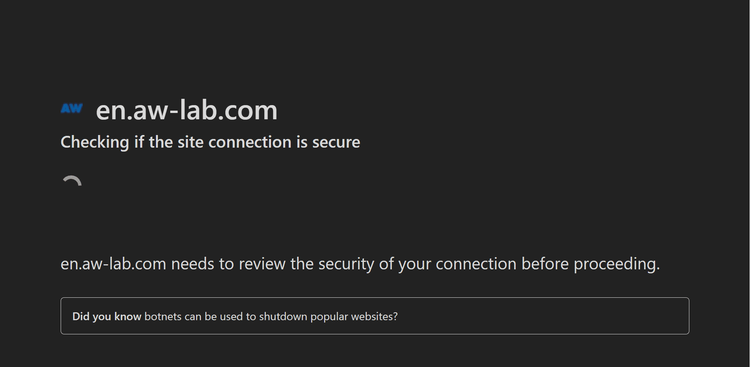
Also known as the Cloudflare JavaScript challenge or the Cloudflare I Am Under Attack page, this is Cloudflare's principal protection. If you want to bypass Cloudflare, you need to skip Cloudflare waiting room.
What is Cloudflare waiting room?
When you visit a Cloudflare-protected site in your browser, you'll first need to wait a few seconds in the Cloudflare waiting room. But what is the point of the waiting room? During that time, your browser solves challenges to prove you're not a robot. If you're labeled as a bot, you'll be given an "Access Denied" error. Otherwise, you'll get automatically redirected to the actual web page.
How long does it take to bypass Cloudflare waiting room?
You'll be placed in the waiting room for a few seconds. The exact time depends on the target's security level and how your scraper does on the tests. For highly protected sites, this process could take five or ten seconds.
Once the challenge has been solved once, you're free to browse the site for a while without needing to wait again.
How Do I Bypass Cloudflare's Waiting Room
Ideally, you can bypass Cloudflare's waiting room by solving the JavaScript challenges and proving you're human.
A viable approach, however, is analyzing Cloudflare's JavaScript challenge to understand the algorithm responsible for generating the challenge and validating the response. This way, you can reverse-engineer the script.
But why is it important to bypass Cloudflare's waiting room?
What Is the Purpose of Bypassing Cloudflare's Waiting Room?
The purpose of bypassing the Cloudflare waiting room is to gain access to onsite data. Every request to a Cloudflare-protected URL encounters the waiting room and must solve the challenges to get redirected to the actual website. Your web scraper has to go through the same process.
Reverse engineering the Cloudflare JavaScript challenge
If you want to make your own bypass for any antibot system, you first need to reverse engineer it. Creating a Cloudflare bypass is no different.
For this example, we're going to reverse engineer the Cloudflare waiting room page as it appears on AW LAB. Feel free to click the link and follow along!
Step 1: check out the network log
First things first, open up the developer tools in your browser and navigate to the 'Network' tab. Then, we'll leave them open and browse the AW LAB site.
After we are redirected from the challenge page to the actual site, we'll notice the following crucial requests (in chronological order):
- An initial
GETtohttps://en.aw-lab.com/, with the response body as the waiting room's HTML. The HTML contains<script>tags containing an important anonymous function. This function does some initialization and loads the "initial challenge" script.
// The script from the waiting room HTML.
(function () {
window._cf_chl_opt = {
cvId: '2',
cType: 'non-interactive',
cNounce: '12107',
cRay: '744da33dfa643ff2',
cHash: 'c9f67a0e7ada3f3',
/* ... */
};
var trkjs = document.createElement('img');
/* ... */
var cpo = document.createElement('script');
cpo.src = '/cdn-cgi/challenge-platform/h/g/orchestrate/jsch/v1?ray=744da33dfa643ff2';
window._cf_chl_opt.cOgUHash = /* ... */
window._cf_chl_opt.cOgUQuery = /* ... */
if (window.history && window.history.replaceState) {
/* ... */
}
document.getElementsByTagName('head')[0].appendChild(cpo);
})();
This script (along with the many more to come) rotates per request, so it may look slightly different for you if you're following along in your browser.
- A
GETto the "initial challenge" script:https://en.aw-lab.com/cdn-cgi/challenge-platform/h/g/orchestrate/jsch/v1?ray=<rayID>, where<rayId>is the value ofwindow._cf_chl_opt.cRayfrom above. It returns an obfuscated JavaScript script, which you can view here. Note: this script rotates changes on each request.

- A
POSTrequest tohttps://en.aw-lab.com/cdn-cgi/challenge-platform/h/g/flow/ov1/<parsedStringFromJS>/<rayID>/<cHash>, where<parsedStringFromJS>is a string defined in the initial challenge script and<cHash>is the value ofwindow._cf_chl_opt.cHash. The request body is a URL-encoded payload of the format:v_<rayID>=<initialChallengeSolution>. The response body to this request seems to be a long base64-encoded string.

- A second
POSTrequest tohttps://en.aw-lab.com/cdn-cgi/challenge-platform/h/g/flow/ov1/<parsedStringFromJS>/<rayID>/<cHash>. The payload follows the same format as the previous request and, once again, returns a long base64-encoded string. This request is responsible for sending the solution of the second Cloudflare challenge.

- A final
POSTrequest tohttps://en.aw-lab.com/, with some crypto form data in this format:
md: <string>
r: <string>
sh: <string>
aw: <string>
This response to this request gives us the actual HTML of the target webpage and a cf_clearance cookie that allows us to freely access the site without needing to solve another challenge.

The request flow doesn't give us too much information, especially since all the data looks to be either encrypted or a random text stream. So, that rules out trying to black-box reverse engineer our way to a Cloudflare bypass.
This might leave you with even more questions than you started with. Where do these requests come from? What does the data in the payloads represent? What's the purpose of the base64 response bodies?
Well, there's no better place to search for answers than the "initial challenge" script. We've avoided looking at Cloudflare's code in-depth up until now, but now we're left with no other choice. Be warned, this is no walk in the park! If you're ready for the challenge, stick with us. We'll start with some dynamic analysis.
Step 2: debug the Cloudflare Javascript challenge script
Cloudflare's scripts are heavily obfuscated. It would be a nightmare to dive right into trying to read the script as-is with little knowledge of its functionality.
Fortunately for us, at the time of writing this, Cloudflare doesn't use any kind of anti-debugging protection. Open up your browser's developer tools, and set up an XHR/fetch breakpoint for all requests:
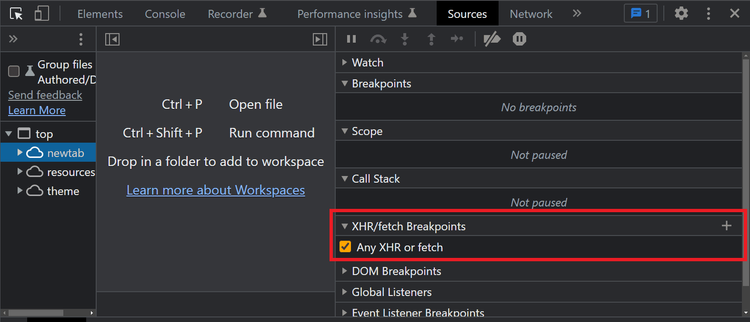
Be sure to clear your cookies so that Cloudflare will place you in the waiting room again. Keeping your developer tools open, navigate to AW LAB.
You'll notice that within a few milliseconds after the "initial challenge" script loads, your XHR breakpoint gets triggered (before the first POST request is sent).
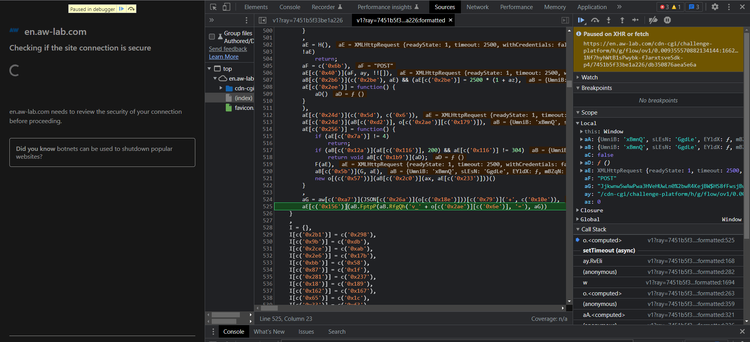
Now, you can see and access all the variables and functions in the current scope. However, there isn't much you can deduce from the variable values shown on-screen, and the code is unreadable.
Looking closely at the script, you'll notice that one function is called over a thousand times. In this example, that's the c function (though it might have a different name in your script). When called, there is always a single stringified hex number as the argument. Let's try running it in the DevTools console:
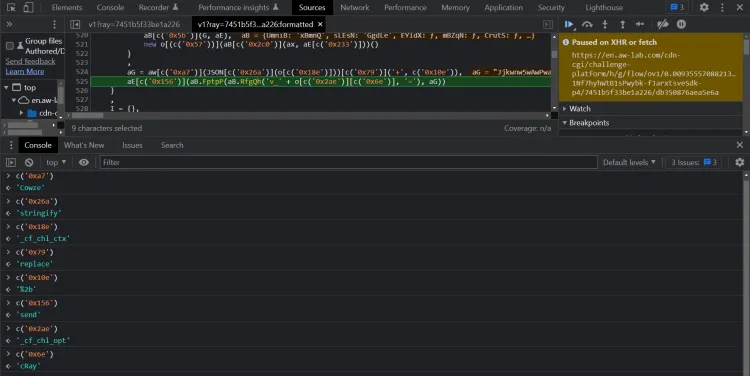
Wow! So it appears that Cloudflare uses a string-concealing obfuscation mechanism. By running the function and replacing its calls with its return values, we can simplify the bottom two lines in the above screenshot to this:
// The simplified code
(aG = aw["Cowze"](JSON["stringify"](o["_cf_chl_ctx"]))["replace"]("+", "%2b")),
aE["send"](aB.FptpP(aB.RfgQh("v_" + o["_cf_chl_opt"]["cRay"], "="), aG));
Using the same technique of running code in the console, we can deduce that the variables o and aE represent window and an XMLHttpRequest instance, respectively. We can also convert bracket notation to dot notation to yield:
// The above code, even more simplified!
(aG = aw.Cowze(JSON.stringify(window._cf_chl_ctx)).replace("+", "%2b")),
// aE = new XMLHttpRequest(), an XMLHttpRequest instance initialized earlier in the script
aE.send(aB.FptpP(aB.RfgQh("v_" + window._cf_chl_opt.cRay, "="), aG));
BoldIt's not perfect, but the code is getting a lot easier for us to read. Simplifying all the string-concealing function calls would improve the script's readability. However, doing it manually would take an eternity. We'll tackle this challenge in the next section, but let's move on for now.
If you press the "continue until next breakpoint" button in your debugger, your browser will send the first post request. Immediately after receiving a response, it will pause on the next breakpoint:
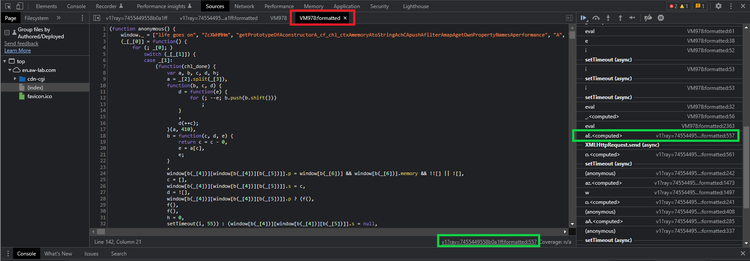
What a plot twist! The debugger is paused in a completely different script. This new script is what we'll call Cloudflare's "main" or "second" Javascript challenge. But if you look at the network log, there was no GET request to this specific script! So, where did it come from?
Taking a closer look at the script, we can see that it's an anonymous function. The script name, in our case, is VM279. According to this thread on StackOverflow, this second script is likely being evaluated within the initial challenge script, using eval or similar. We can confirm this because the call stack shows the Cloudflare "initial challenge" script as the initiator (see: green boxes in the screenshot)!
If we click on the initiator, we can see where this script is being evaluated in the "initial challenge" script:
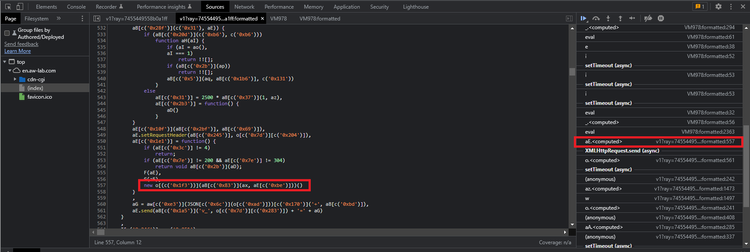
We'll use the same method of evaluating the c function calls to undo the string concealing and replacing o with window, which gives us this:
// The line of code that initiates the second JavaScript challenge
// Note: aE = new XMLHttpRequest(), an XMLHttpRequest instance initialized earlier in the script
new window.Function(aB.pgNsC(ax, aE.responseText))();
It looks like this function is creating a new function based on the data contained in the responseText of the XMLHttpRequest from the previous breakpoint. Cloudflare probably uses some cipher to decrypt it into an executable script.
Okay, we've made some progress. Yet as is, the Cloudflare scripts remain unreadable. Even with manual debugging, we won't be able to figure out much more. If you want to create a Cloudflare bypass, we need to be able to understand it fully. And to do that, we need to deobfuscate it.
Step 3: deobfuscate the Cloudflare Javascript challenge script
This isn't going to be trivial. Cloudflare uses a lot of obfuscation techniques in its code, and it wouldn't be practical to cover them all in this article. Here's a (non-exhaustive) list of examples:
-
String Concealing. Cloudflare removes all references to string literals. In the previous section, we saw that the
cfunction acted as a string concealer. -
Control Flow Flattening. Cloudflare obscures the control flow of a program by emulating assembly-like
JUMPinstructions by using an infinite loop and a central switch statement dispatcher. Here's an example from the Cloudflare script:
// An example of control flow flattening from the Cloudflare script.
function Y(ay, aD, aC, aB, aA, az) {
// The aB array holds a list of all the instructions.
aB = "1|6|11|0|15|9|3|10"["split"]("|");
// This is the infinite loop
for (aC = 0; true; ) {
// The below switch statement is the "dispatcher"
// The value of the aB[aC] acts as an instruction pointer, determining which switch case to execute.
// After each switch statement finishes executing, the instruction pointer is incremented by one to retrieve the next instruction.
switch (aB[aC++]) {
case "0":
/* ... */
continue;
case "1":
/* ... */
continue;
case "3":
/* ... */
continue;
case "6":
/* ... */
continue;
case "9":
/* ... */
continue;
case "10":
// Exit the function. This is the final switch case
return aD;
case "11":
/* ... */
continue;
case "15":
/* ... */
continue;
}
break;
}
}
Italic- Proxy Functions. Cloudflare replaces all binary operations (+,-,==, / etc.) with function calls. This decreases code readability, as you constantly need to look up the definition of the extra functions. Here's an example:
// An example of proxy function usage
az = {};
// '+' operation proxy function
az.pNrrD = function (aB, aC) {
return aB + aC;
};
// '-' operation proxy function
az.aZawd = function (aB, aC) {
return aB - aC;
};
// '===' operation proxy function
az.fhjsC = function (aB, aC) {
return aB === aC;
};
/* ... */
// Equivalent to ((1 + 3) - 4) === 0
az.fhjsC(az.aZawd(az.pNrrD(1, 3), 4), 0);
- Atomic Operations. Especially in the main/second challenge script, Cloudflare converts simple strings or numeric literals into long, convoluted expressions taking advantage of the atomic parts of javascript (unary expression, math operations, and empty arrays). This technique is very reminiscent of JSFuck. Example:
// Believe it or not, this is equivalent to:
// a = 1.156310815361637
a =
(!+[] +
!![] +
!![] +
!![] +
!![] +
!![] +
!![] +
!![] +
!![] +
[] +
(!+[] + !![] + !![] + !![]) +
-~~~[] +
(!+-[] + +-!![] + -[]) +
(!+[] + !![] + !![] + !![] + !![] + !![] + !![] + !![]) +
(!+[] + !![] + !![]) +
(!+[] + !![] + !![] + !![] + !![] + !![] + !![] + !![] + !![]) +
(!+[] + !![] + !![] + !![] + !![] + !![] + !![] + !![]) +
-~~~[]) /
+(
!+[] +
!![] +
!![] +
!![] +
!![] +
!![] +
!![] +
!![] +
[] +
-~~~[] +
(!+[] + !![] + !![]) +
(!+[] + !![] + !![] + !![] + !![] + !![] + !![] + !![]) +
(!+[] + !![] + !![] + !![] + !![] + !![]) +
(!+[] + !![] + !![] + !![] + !![] + !![] + !![]) +
(!+[] + !![] + !![] + !![] + !![] + !![]) +
(!+[] + !![] + !![] + !![] + !![] + !![]) +
(!+[] + !![] + !![])
);
What makes developing a Cloudflare bypass non-trivial is its script's obfuscation and dynamic nature. Each time you enter a Cloudflare waiting room, you're going to be faced with new challenge scripts.
If you want to create your own Cloudflare bypass, you'll need some highly-specialized skills. The obfuscation of Cloudflare's challenge scripts is good enough that you can't just throw it in a general-purpose deobfuscator and get a readable output. You'll need to create a custom deobfuscator capable of dynamically parsing and transforming each new Cloudflare challenge script into human-readable code. Hint: Try manipulating the script's abstract syntax tree
Once you've made a working dynamic deobfuscator, you'll be able to better understand all the checks Cloudflare's anti-bot performs on your browser and how to replicate the challenge-solving process.
In the next step, we'll analyze some active bot detection implementations from the deobfuscated Cloudflare script. Let's get to it!
Step 4: analyze the deobfuscated script
Remember those cryptic payloads and base64 encoded response bodies? Well, now we can understand how they work!
Cloudflare's encryption
Recall this code snippet, where we determined that the response text was being used to evaluate the main/second challenge script:
// Note: aE = new XMLHttpRequest(), an XMLHttpRequest instance initialized earlier in the script
new window.Function(aB.pgNsC(ax, aE.responseText))();
_Italic_The deobfuscated version looks like this:
// Note: aE = new XMLHttpRequest(), an XMLHttpRequest instance initialized earlier in the script
new window.Function(ax(aE.responseText))();
In the end, ab.pgNsC was just a proxy wrapper for the ax function. The deobfuscated ax function looks like this:
ax = function (ay) {
var aF;
var aE = window._cf_chl_opt.cRay + "_" + 0;
aE = aE.replace(/./g, function (_, aH) {
32 ^= aE.charCodeAt(aH);
});
ay = window.atob(ay);
var aD = [];
for (
var aB = -1;
!isNaN((aF = ay.charCodeAt(++aB)));
aD.push(String.fromCharCode(((aF & 255) - 32 - (aB % 65535) + 65535) % 255))
) {}
return aD.join("");
};
Can you guess what this function does? It's a decryption function!
Cloudflare encrypts the main/second challenge script with a cipher. Then, after the first POST request to solve the initial challenge, Cloudflare returns the encrypted second challenge script.
To actually execute the challenge, it's decrypted into a string with the ax function using window._cf_chl_opt.cRay as the decryption key. That string is then passed into the Function constructor to create a new function and executed with ()!
We also previously discussed Cloudflare's active bot detection techniques. Now, we can revisit a few of them to see their implementations!
CAPTCHAs
Here, we can see how Cloudflare loads an hCaptcha instance:
o["_cf_chl_hload"] = function () {
o["_cf_chl_hloaded"] = true;
};
q["push"](function (aD, aC, aA, az, ay) {
aA = false;
o["setTimeout"](aB, 3500);
aC = p["createElement"]("script");
aD = "https://cloudflare.hcaptcha.com/1/api.js?endpoint=https%3A%2F%2Fcloudflare.hcaptcha.com&assethost=https%3A%2F%2Fcf-assets.hcaptcha.com&imghost=https%3A%2F%2Fcf-imgs.hcaptcha.com&";
o["_cf_chl_hlep"] = "2";
aC["src"] = aD + "render=explicit&recaptchacompat=off&onload=_cf_chl_hload";
aC["onerror"] = aB;
p["getElementsByTagName"]("head")[0]["appendChild"](aC);
function aB(aI, aH, aG, aF, aE) {
if (o["_cf_chl_hloaded"]) {
return;
}
if (aA) {
return;
}
/* ... */
}
});
Canvas fingerprinting
In this snippet, Cloudflare is creating an array of canvas fingerprinting functions for use later on in the script:
S = [
/* ... */
function (a3, a4, a5, af, ae, ad, ac, ab, aa, a9, a8, a7, a6) {
a3.shadowBlur = 1 + O(L);
a3.shadowColor = R[O(R.length)];
a3.beginPath();
ad = a4.width / H;
ae = a4.height / H;
a8 = ad * a5 + O(ad);
a9 = O(ae);
a3.moveTo(a8 | 0, a9 | 0);
af = a4.width / 2 + O(a4.width);
aa = O(a4.height / 2);
ac = a4.width - a8;
ab = a4.height - a9;
a3.quadraticCurveTo(af | 0, aa | 0, ac | 0, ab | 0);
a3.stroke();
return true;
},
/* ... */
];
Timestamp tracking
There are many places in the script where Cloudflare queries the browser for timestamps. Here's an example:
k = new Array();
pt = -1;
/* ... */
if (window.performance.timing && window.performance.timing.navigationStart) {
ns = window.performance.timing.navigationStart;
}
for (var j = 0; j < 10; j++) {
k.push(Date.now() - ns - pt);
}
Event tracking
Here, we can see that Cloudflare adds EventListeners to the webpage to track mouse movements, mouse clicks, and key presses.
function x(aE, aD, aC, aA, az, ay) {
aA = false;
aE = function (aF, aG, aH) {
p.addEventListener
? p.addEventListener(aF, aG, aH)
: p.attachEvent("on" + aF, aG);
};
aE("keydown", aB, aD);
aE("pointermove", aB, aD);
aE("pointerover", aB, aD);
aE("touchstart", aB, aD);
aE("mousemove", aB, aD);
aE("click", aB, aD);
function aB() {
/* .. */
}
}
Automated browser detection
Here are a few of the checks Cloudflare has to detect the use of popular automated browsing libraries:
function _0x15ee4f(_0x4daef8) {
return {
/* .. */
wb: !(!_0x4daef8.navigator || !_0x4daef8.navigator.webdriver),
wp: !(!_0x4daef8.callPhantom && !_0x4daef8._phantom),
wn: !!_0x4daef8.__nightmare,
ch: !!_0x4daef8.chrome,
ws: !!(
_0x4daef8.document.__selenium_unwrapped ||
_0x4daef8.document.__webdriver_evaluate ||
_0x4daef8.document.__driver_evaluate
),
wd: !(!_0x4daef8.domAutomation && !_0x4daef8.domAutomationController),
};
}
Sandboxing detection
In this snippet, the script checks if it's running in a NodeJS environment by searching for the node-only process object:
(function () {
SGPnwmT[SGPnwmT[0]] -= +(
(Object.prototype.toString.call(
typeof globalThis.process !== "undefined" ? globalThis.process : 0
) ===
"[object process]") ===
false
);
/* ... */
});
To detect any modification of native functions (ex., monkey patching), Cloudflare executes toString on them to check if they return the "[native code]" or not.
c = function (g, h) {
return (
h instanceof g.Function &&
g.Function.prototype.toString.call(h).indexOf("[native code]") > 0
);
};
Step 5: putting it all together
Phew, it's been quite the journey so far! We know, that was a lot to take in. Let's take a short break and reflect on what you've learned so far:
- The purpose of Cloudflare's anti-bot
- The active and passive bot detection techniques Cloudflare uses
- What is the Cloudflare waiting room/challenge page
- How to reverse engineer the Cloudflare waiting room's request flow
- How to deobfuscate the Cloudflare challenge scripts
- How Cloudflare implements bot detection techniques in their Javascript challenge
Now, the last step is to put all of that knowledge together and bypass Cloudflare!
Method #3: Use Cloudflare solvers
There are several tools and libraries available that claim to bypass the Cloudflare challenge. Some are completely out of date and some others under active maintenance.
- Cfscrape.
- cloudscraper.
- FlareSolverr.
- cloudflare-scrape.
- cloudflare-iuam-solver.
- CloudflareSolverRe.
Some used to work seamlessly but didn't keep up with the latest security updates:
cloudscraper.exceptions.CloudflareChallengeError: Detected a Cloudflare version 2 Captcha challenge, This feature is not available in the opensource (free) version.
Most opt for the static bypass while others, like FlareSolverr, go the headless browser way. It internally uses Selenium with undetected-chromedriver to access the target site like a regular user would.
As its developers say: "Web browsers consume a lot of memory". That's one of the reasons that most try to do it without using them. Be careful when trying to scrape at scale using this solution (more information in the next section).
Method #4: Implement fortified headless browsers
Following FlareSolverr's idea, you can try running headless browsers on your own. But read on before implementing this option.
Since headless browsers are designed for testing and not for scraping, they have several traits that make them easily identifiable by Cloudflare, like exposing navigator.webdriver as Selenium does.
Don't worry, there are solutions for each of the most popular headless browsers:
- Selenium: undetected_chromedriver optimizes and patches the base Selenium, making it ready to bypass Cloudflare.
- Puppeteer: the stealth plugin is a must when using Puppeteer. And the Puppeteer extra library comes with other useful plugins (i.e., adblocker 😉).
- Playwright: the stealth plugin mentioned above is available for Playwright too!
These are all great projects and even better with the scraping patches applied, but they come with important downsides, such as the memory and resource consumption mentioned above. And, if you are not careful, the bandwidth.
A regular page might be around 10-50 kB, or less when compressed. If we add all the resources (CSS, JavaScript, images), that can easily turn into 1-5 MB. And you'll probably need proxies, right? Many of those charge per GB; not good news.
You can block some resources, like images, because you probably won't need them. But be careful when blocking; too aggressive and Cloudflare will detect you.
To be noted, anti-bot systems load certain assets to perform their checks. JavaScript is the one everyone talks about, but they won't limit it to that. Sometimes images and/or stylesheets are also important, and not loading them is a clear indicator for the security system to stop you.
Method #5: Smart proxy to bypass Cloudflare
Most of the time, it's just not practical to spend massive amounts of time, energy, and money developing plus maintaining your own solver... or paying for bandwidth and resources employed by headless browsers. You've seen that the Cloudflare waiting room bypass is possible but will require massive work.
There are alternatives to the open-source solvers seen above, usually called smart proxies, anti-bot APIs or, in this case, a Cloudflare bypass proxy. It'll run the needed checks and solvers behind the scenes to return you the data. No worries on your side, and spending less resources.
It might work on both API or proxy mode. You perform a regular request (think of a regular cURL call), and there will be no resources wasted on your end, with just a minimum of computing time.
ZenRows is a Cloudflare bypass proxy or API that also works with all the other antibot solutions. Stop worrying about the intricacies of detection techniques, dynamic obfuscation, challenge solving, or updates. Offering both API and proxy modes, ZenRows can be seamlessly integrated into any of your scraping projects.
# pip install requests
import requests
url = 'https://www.g2.com/products/asana/reviews'
apikey = '<YOUR_ZENROWS_API_KEY>'
params = {
'url': url,
'apikey': apikey,
'js_render': 'true',
'antibot': 'true',
'premium_proxy': 'true',
}
response = requests.get('https://api.zenrows.com/v1/', params=params)
print(response.text)
# ... <title>Asana Reviews 2023: Details, Pricing, & Features | G2</title> ...
Focus on your data scraping vision, and let ZenRows handle the rest.
Method #6: Scrape Google cache
Sometimes, we try to force the door when the window is open. Sites like Google Cache or Internet Archive have copies of many websites, so we should ask ourselves:
- Is the data I need present there? And updated?
- Is the security level lower than my original target?
If the answer to both is true and none of the previous methods worked for you, let's try this last bullet.
You can start by manually searching your target on Google to see if it has the cache version. Click on the three dots icon next to the site's domain name or breadcrumbs and it'll show a pop-up like this one:
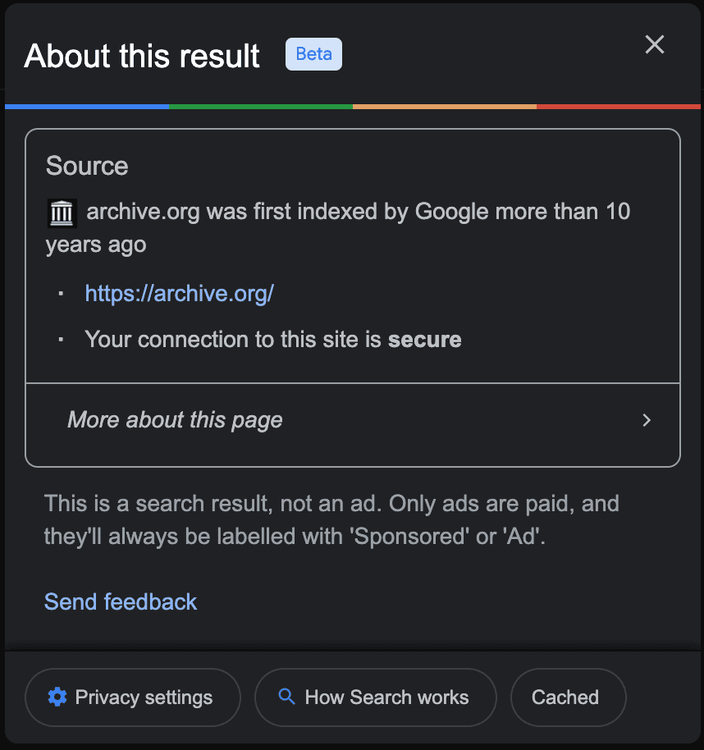
The "Cached" link there will offer you the last page version. The links has the following URL:
https://webcache.googleusercontent.com/search?q=cache:gsruBfntoNQJ:https://archive.org/
You can ignore the code after cache: for your scraping and plug in the URL directly.
Method #7: Cloudflare CAPTCHA bypass
Solving Cloudflare CAPTCHAs isn't a cheap task, but avoiding them is a bit easier and more convenient.
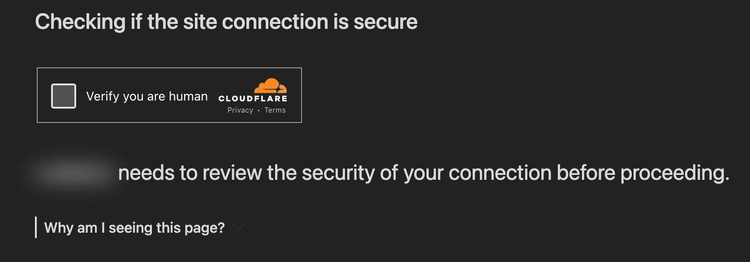
The challenge: the sites with the highest security level provided by Cloudflare will show the CAPTCHA check even to regular users using regular browsers.
Do you remember the analogy about the door and the window? Sometimes, the only thing left to do is kick the door open.
The solution here might be building a Cloudflare CAPTCHA bypass using a solver service like 2captcha. These services will show the captcha to real people for them to solve manually. Then, it will return you the solution and you can continue with that.
But those services are slow, and quite expensive at scale. But you can use them as a plan B for the cases where all the other methods fail.
Try to analyze and understand your target. Some sites will only use the maximum security level at certain hours or days of the week. If you can identify them and skip those, you won't need to add the extra effort of CAPTCHA solvers. Additionally, we'd suggest applying some (or all) of the methods explained.
Method #8: API to bypass Cloudflare
Most of the time, it's just not practical to spend massive amounts of time, energy, and money developing and maintaining your own solver. You've seen that the Cloudflare waiting room bypass is possible but will require massive work.
ZenRows is a Cloudflare bypass API that also works with all the other antibot solutions. Stop worrying about the intricacies of detection techniques, dynamic obfuscation, challenge solving, or updates. Offering both API and proxy modes, ZenRows can be seamlessly integrated into any of your scraping projects.
Focus on your data scraping vision, and let ZenRows handle the rest.
DYI Cloudflare bypass
We already mentioned that it's not an easy feat, but how do you bypass the Cloudflare waiting room on your own?
Let's say that none of the options above work for your use case. Or you're investigating and want to build your own method. You can, of course, learn from all the options and how these projects approach the problem. To bypass Cloudflare's protection, you'll need to combine all the knowledge you've gained from the previous sections.
As you know by now, Cloudflare has two bot detection methods: passive fingerprinting and active bot detection (through their JavaScript challenge). To bypass Cloudflare, you sneak under the radar of both of them. To get you started, here are some tips for each.
Bypassing Cloudflare passive bot detection
- Use high-quality proxies. To disguise your scraper as a legitimate user, use residential proxies. Datacenter proxies and VPNs are easily detected by Cloudflare and are classified as suspicious traffic. Additionally, too many requests from a single IP address can lead to blocks, so be sure to rotate out your proxies each session to avoid that. If you're still facing blocks, a specialized Cloudflare CAPTCHA proxy will help you bypass them and skip the waiting room.
- Mimic your browser's headers. Make your scraper's requests look as real as possible by making sure to send all the HTTP headers from the original request. This includes having valid cookie headers for each request!
- Match a whitelisted fingerprint. If you decide to go the browser automation route, your scraper might fulfill this requirement by default. But, only provided that you use the exact user agent and browser version the library is built upon. This becomes a lot more tedious when developing a fully request-based scraper. You'll need to capture and analyze packets from the browsers you intend to impersonate. Your selection of programming languages is limited. It must have enough low-level access to control all the components to Cloudflare's TLS and HTTP/2 fingerprinting specification, so you can match a browser 1:1.
Remember, passive bot detection is Cloudflare's first layer of defense. If you want to bypass Cloudflare, you can't neglect this step.
If your activity is labeled suspicious by their passive bot protection system, you'll be blocked immediately. On the contrary, slipping past them might even allow you to skip over the active bot protection checks.
Bypassing Cloudflare active bot detection
- Reconstruct the challenge-solving logic. This requires an expert understanding of the Cloudflare waiting room's internals. Study its request flow and deobfuscated script. You'll need to figure out exactly what checks Cloudflare performs, in what order they're executed, and how you can bypass them. You also need to replicate the encryption and decryption of Cloudflare's various payloads. This is the most difficult part of creating a bypass since the Cloudflare challenge scripts are dynamic. Every session might even require you to deobfuscate a new script on the fly, to parse specific values for use in your solver.
- Collect Real Device Data. Even if you understand exactly how they're made, some fingerprints are too impractical to attempt impersonating. For example, Cloudflare's Canvas fingerprinting. Unlike a TLS or HTTP/2 fingerprint, it relies heavily on moving parts from both software and hardware. The functionality of hardware components is way too advanced to try and imitate and not something you want to spend all your time designing for a scraping project. Instead, consider collecting fingerprint data from real users' devices. Then, you can inject this data into your solver whenever it needs to be used. But you won't get far with just a few. Your best option would be to host a collector on a high-traffic webpage to ensure you have enough devices to avoid looking suspicious to Cloudflare's machine learning systems.
- Use Automated Browsers / Sandbox The Script. If you want to abstract some of the challenge-solving logic, you might consider directly executing the Cloudflare JavaScript challenges. This could be in-browser using automated tooling or by emulating a browser in a sandbox such as JSDOM. The downside to this approach is the performance. Running or emulating a browser environment will be much slower and compute-expensive than a request/algorithm-based challenge solver. Also, recall that Cloudflare has checks for automated browsers and sandboxing. To bypass them, you first must understand which ones exist and how they work. So, sandboxed or not, you won't be able to skip deobfuscating the Cloudflare challenge scripts! You can achieve headless browser Cloudflare bypass, but it will take some effort.
If you've gotten this far, great job! You're now familiar with the process of making a solver for Cloudflare's antibot challenge.
Don't fret if you found yourself feeling lost during the process. We get it, bypassing any antibot can feel like a daunting task. But that doesn't mean you should give up on your scraping project!
Bypassing Cloudflare from scratch is a complicated task, and there aren't any shortcuts if you plan to do it yourself. But it doesn't have to be this difficult! Sometimes, it's best to have someone else take care of it for you.
Conclusion
Congratulations on sticking with us to the end! We know it was a lengthy read, but Cloudflare's high complexity made it necessary.
Thanks for reading! We hope this guide has helped you learn valuable knowledge about Cloudflare's bot detection techniques, how to reverse engineer them, and ultimately how to bypass Cloudflare waiting room. The methodology you learned today isn't just Cloudflare-specific either: you can go back to it to help bypass other antibots!
Speaking of other antibots, click here to read about how to bypass Akamai's Bot Manager.
Thanks for reading! We hope that you found this guide helpful. You can sign up for free, try ZenRows, and let us know any questions, comments, or suggestions.
Frequent Questions
Is It Possible to Bypass Cloudflare?
Yes, it's possible to bypass Cloudflare. Its anti-bot techniques can be classified into two, namely, passive fingerprinting and active anti-bot detection. So, to bypass Cloudflare, you must find your way around them.
Why Is My IP Blocked by Cloudflare?
Cloudflare may block your IP if you exhibit bot-like behavior, such as quickly making too many requests, using non-browser user agents, etc. Another reason could be that your IP has been blocklisted due to association with suspicious activity.
How Do You Beat Cloudflare?
You can beat Cloudflare by fortifying your web scraper to make requests appear as if from a real user. Other approaches include:
- Reverse engineering Cloudflare's anti-bot challenges.
- Scraping Google cache.
- Sending your requests directly to the origin server.
- Using a smart proxy like ZenRows.
Did you find the content helpful? Spread the word and share it on Twitter, or LinkedIn.